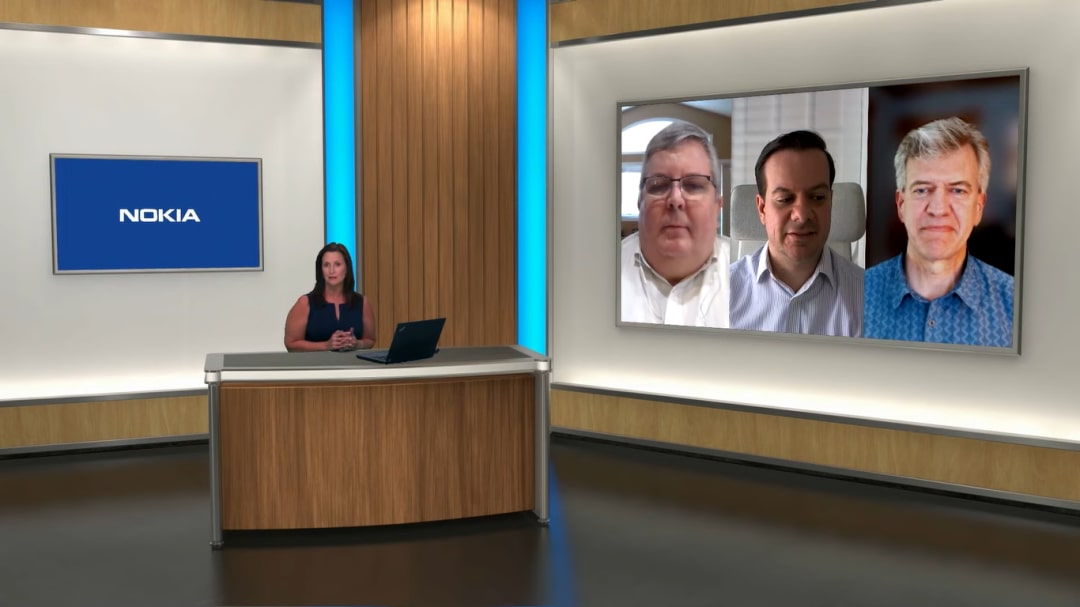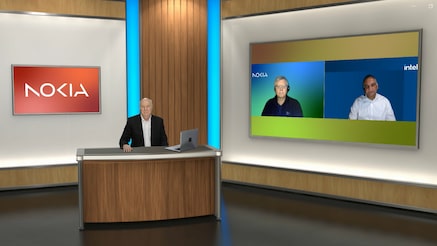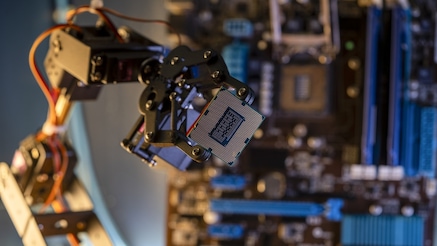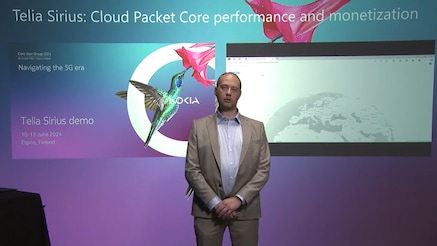Cloud Packet Core (CPC)
Reach new heights in performance to deliver 5G services with confidence

Take advantage of multi-cloud capabilities and any access (2G/3G/4G/5G and wireline), while minimizing implementation risks and serving any demand with the right capacity, maximum performance and lowest latency. Deploy your evolved packet core (EPC) and 5G core (5GC) with the flexibility of cloud-native network functions (CNFs), physical network functions (PNFs) and pre-integrated server-based appliances.
- What is Packet Core?
- Features and capabilities
- Cloud Packet Core video series
- Cloud Packet Core Appliances
- 5G Monetization with CPC
- Cloud Packet Core explained
- Cloud Packet Core products
- Energy saving with CPC
- Our partnership with Intel
- Key design principles
- Certification and training
- Related products and solutions
- Learn more
What is packet core?
The Nokia packet core provides key components needed for a webscale-class evolved packet core (EPC) and 5G core system (5GC). With its virtualized, cloud-native disaggregated and state-efficient design, it is well suited for multi-cloud environments. It is also infrastructure agnostic and independent of the underlying cloud infrastructure used for orchestration, lifecycle management (LCM) and infrastructure resource management.
Pre-integrated appliances offer network growth, deliver additional functionality and mitigate end of life challenges due to limited cloud infrastructure. The Nokia packet core can anchor both wireless (2/3/4/5G NSA and SA) and wireline (xDSL, PON, fiber) access technologies, forming a universal adaptive core.

Packet core features and capabilities
Capture new revenue opportunities by delivering a diverse range of exciting services. This requires a feature-rich, high-performing, capable and reliable packet core that can be deployed without limitations and evolved with confidence on any cloud and using any access technology (2G/3G/4G/5G).
Deploy with flexibility, ensure performance
Find out how Nokia’s packet core flexibility meets your needs wherever you are on your cloud journey.
- Minimized latency - a compact, high performance and distributed packet core for user plane slice selection and local traffic offload helps to meet the needs of ultra-reliable low latency use cases.
- Increased flexibility - packet core network functions can be introduced or expanded rapidly with a simple software upgrade or a pre-integrated appliance.
- Resource efficiency - the unified control plane can manage multiple wireless and wireline user plane functions located anywhere in the network.
Maximize throughput, minimize latency
Find out how Nokia’s packet core helps you to achieve industry-leading performance from integrated IP services and a high-performance IP forwarding engine.
- Cost-effective network - 3.5x greater throughput compared to dedicated external network elements.
- Improved customer experience - the high performance packet core gateway minimizes latency for the delivery of uRLLC use cases.
- Lower OPEX - fewer network functions need to be processed and maintained.
Observe your packet core performance
Find out how Nokia packet core's observation capability leads you to effective operations and monetization.
- Performance analysis - analysis of individual device sessions and behavior is enabled by packet core network function per call measurement data (PCMD) for detailed insights to help maintain service performance.
- Visibility at all levels - monitoring overall packet core network with per-interface and per-flow granularity enables you to get ahead of issues.
- Openness - open cloud native computing foundation (CNCF) components can be used for easy logging, tracing and monitoring.
Cloud Packet Core video series
The packet core is arguably the most important technology for helping communications service providers (CSPs) get the biggest benefits from the many opportunities 5G creates. To illustrate why, we’ve created these short videos with the priorities that CSPs tell us they must address and our vision of technology trends.
Packet Core Appliances for achieving high performance at the edge
Nokia's Packet Core Appliances® provide an innovative solution for CSPs navigating the high-performance and capacity demands of edge computing. These pre-packaged software units, optimized for high-performance servers, enable network disaggregation, agility, and operational simplification.
Key benefits include efficient deployment, reduced infrastructure needs, and automated custom deployment processes. Control Plane and User Plane Appliances offer scalable capacity, cost-effectiveness, and support for Mobile Edge Computing (MEC), significantly reducing latency and enhancing network reliability. Examples such as Fixed Wireless Access (FWA) and Ultra-Reliable Low-Latency Communication (URLLC) services demonstrate the versatility and potential of Appliances in various high-demand applications.
5G Monetization with Cloud Packet Core
5G has an increasing potential for cost optimization and revenue generation. Together with automation, performance, flexibility, and innovation, a clear use case with positive ROI is one of the most important drivers for CSPs to step ahead and initiate the evolution of existing networks.
5G Monetization use case for enterprises with Fixed Wireless Access (FWA)
A well-known use case is Fixed Wireless Access (FWA), where end users benefit from 5G high speeds and low latency for multiple applications. Now, we are moving one step further and improving this solution to meet enterprises' needs using Ethernet over Fixed Wireless Access or simply EoFWA. This new solution enables L2 connectivity through multiple sites while delivering all 5G benefits.
To explore further, read Mike Hawley’s blog to learn why "Ethernet over FWA means business." Additionally, you can discover “How to get the most out of FWA over the converged Nokia 5G Core” by reading this whitepaper. If you're interested in use cases, we have a short video demonstrating how this solution is helping to bridge the digital divide. For a real-life example, Telenet Belgium shares their expectations and experiences with EoFWA.
MWC 2024 Ethernet over 5G FWA demo
At Mobile World Congress 2024, we proudly showcased a live demonstration of our innovative Cloud Packet Core feature, which facilitates Ethernet connections over 5G Fixed Wireless Access (FWA). We highlighted two key use cases during this demonstration.
- The first use case illustrated how enterprises can now extend their Virtual Local Area Networks (VLANs) to remote locations using Layer 2 connections. This solution is not only affordable, but also reliable and secure, making it an excellent choice for businesses.
- The second use case demonstrated how Fixed Internet Service Providers can leverage the Communication Service Provider's (CSP's) 5G infrastructure to deliver internet connections to users beyond their existing cabling reach.
Cloud Packet Core Explained
Cloud Packet Core plays a fundamental role on 5G Packet Data networks, especially when it comes to Stand Alone Core and Service Based Architecture. 5G brings concepts that are new to the telecommunications world. Although some of them like Virtualization, Cloud Core and Cloud Native are grounded by now, other ones may still raise questions. To help clarify some of these concepts, we created the videos below. Please watch them and leave your comments.
Packet core products
The Nokia packet core consists of the Cloud Mobile Gateway (CMG), Cloud Mobility Manager (CMM) and Cloud Network Resource Director (CNRD). These products provide key components of an evolved packet core (EPC), a 5G core (5GC) and 2G/3G mobile packet core domains for the creation of a single packet core network.
Cloud Mobile Gateway
The Cloud Mobile Gateway (CMG) supports multi-access connectivity by converging multiple mobile packet core gateway functions.
In 4G evolved packet core (4G EPC) networks this includes the serving gateway/packet data network gateway/ gateway GPRS support node (SGW/PGW/GGSN), policy control enforcement function (PCEF), subscriber services gateway (SSG) providing carrier-grade network address translation (NAT), TCP optimization, firewall and service chain steering capabilities, hybrid access gateway (HAG) for converged service delivery, home agent node (HA), evolved packet data gateway (ePDG) and trusted wireless access gateway (TWAG).
In 5G core (5GC) networks this includes the session management function (SMF) and user plane function (UPF).
Cloud Mobility Manager
The Cloud Mobility Manager (CMM) is a key control plane element of the Nokia packet core solution built to support the growth of diverse services as well as the evolution to a 5G core system (5GC).
In 4G evolved packet core (4G EPC) networks the CMM provides the mobility management entity (MME) function, and the serving GPRS support node (SGSN) function in 2G/3G mobile packet core networks.
In 5G core (5GC) networks the CMM provides the access and mobility management function (AMF).
Cloud Network Resource Director
The Cloud Network Resource Director (CNRD) provides two 5G core (5GC) network functions: Network Repository Function (NRF) and Network Slice Selection Function (NSSF), as defined in the 3GPP SBA (Service Based Architecture).
The NRF stores the network function (NF) registration information. It allows NF to act as "Producer" or "Consumer" of services, besides subscribing to services from other network functions.
The NSSF defines the correct network slice from the list pre-defined ones, to serve a specific device. It also sets the correct NF and resources to serve the requesting device.
5G Packet Core energy saving
Nokia is committed to prioritizing energy efficiency in its products and solutions. The Cloud Packet Core leverages the latest chipset features, such as P-State and C-State capabilities, to their fullest potential. P-states allow for CPU frequency adjustment on a per-core basis, while C-states enable the CPU to enter various sleep modes. By combining these modes, Nokia effectively reduces power consumption.
Additionally, Nokia has integrated Artificial Intelligence and Machine Learning into its Cloud Packet Core, utilizing computational algorithms to learn and predict network patterns. This includes the implementation of a Traffic Load Prediction Model, which triggers the Kubernetes Horizontal Pod Auto-scaler based on machine learning results, using just the number of CPUs needed to serve the demand. In collaboration with Intel, Nokia is focused on achieving greater energy efficiency in 5G networks by utilizing Xeon processors and Intel's power management software. These advancements, built upon years of innovation, provide communication service providers (CSPs) with enhanced capabilities to reduce electricity usage and costs within their networks.
Nokia strengthens strategic partnership with Intel
Nokia is committed to enhancing its solutions to provide more efficient networks for CSPs. Building on our partnership with Intel, we recently benchmarked our Cloud Mobility Manager (CMM) software on Intel's latest Xeon 6 processor with E-cores. The results showed a 2.7-fold increase in performance and an 80% improvement in power efficiency compared to the most widely deployed 3rd Generation Xeon scalable processors. Nokia will introduce Intel’s Xeon 6 processor E-cores with it’s cloud-native Core solutions starting early 2025.
5G Packet Core security
Nokia Cloud Packet Core is cloud native by design. It provides high performance and latency thanks to modern architecture, enabling multi-cloud and appliances-based deployments. It also allows wireline (optical, fiber, cable) and wireless (2G/3G/4G/5G) convergence.
It is designed for privacy and security, with layered protection based on defense-in-depth design and zero-trust principles and tested against 5G-specific use cases.CSPs get full control to secure their 5G services, thanks to the pervasive and automated security management built into our design practices, 5G core software, and dedicated security solutions.
Packet core and 5G core (5GC) certification and training
The Nokia 5G packet core overview eLearning module introduces the 5G core (5GC) system architecture and highlights its characteristics. It describes the Nokia solution for 5G non-standalone option 3X. It also examines the concept of network slicing, main concepts of 5G core security and the architecture of the 5G core system (5GC) by highlighting each network function's role. Demonstrations and uses cases are integrated throughout the course to reinforce learning objectives.
After completing the course, students should be able to:
- Identify the drivers and benefits of 5G
- Present the 5G core (5GC) system architecture and its deployment options
- Describe the 5G non-standalone option 3X
- Illustrate the 5G core system (5GC) architecture
- Identify the role of each network function in the 5G core (5GC)
- Describe the service-based architecture in the 5G core system (5GC)
- Describe the packet core mobility and session management functions in the 5G core (5GC)
- Describe the concept of 5G core (5GC) network slicing
- Explain the 5G quality of service (QoS) framework and the main components of 5G core (5GC) security[FU2]
For further details visit the Cloud Packet Core certification and evolution to 5G webpage.
Related products and solutions
Product
Get the flexibility, scale, and performance you need for enhanced broadband, uRLLC and 5G services on any cloud
Product
Leverage cloud-native design to boost performance and scalability
Learn more about our cloud-native packet core

Blog
Blog

Customer success
Video
Moving towards energy efficiency with 5G Packet Core

Blog

Blog

Customer success
Video
Nokia helps Telia Denmark achieve leading network performance
Latest news
Please complete the form below.
The form is loading, please wait...
Thank you. We have received your inquiry. Please continue browsing.






